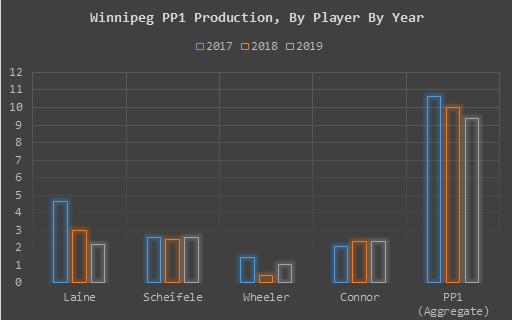Nov 23, 2020
With or without Laine, Jets have work to do on power play
The talent is clearly there to make Winnipeg’s power-play unit one of the deadliest in the league again, Travis Yost writes.
By Travis Yost

Perhaps the most interesting name mentioned in trade rumours this off-season has been Winnipeg Jets winger Patrik Laine.
It’s not often a player manages four consecutive (pro-rated) 30-goal seasons, and it’s even rarer when it happens before a player’s 23rd birthday. To that end, Laine is a unicorn of sorts – and a valuable one at that.
The situation between Laine and the Jets can seem a bit awkward at times. Laine has never been fully satisfied with his usage – the mere fact that such a prolific scorer can’t seem to crack the first line on a talent-average hockey team is puzzling – but the trust from head coach Paul Maurice hasn’t been there. That lack of trust stems largely from Laine’s off-puck play and Winnipeg’s woeful defensive performance numbers with Laine on the ice.
The argument in defence of Laine is quite simple: whatever defensive concerns the team may have, he is still on the right side of goal differentials since entering the league (183 goals for, 178 goals against at even strength since 2016-17).
The counterargument is that there should be much more daylight in those goal differentials when you are dressing a player who can seemingly score at will. Add an expiring contract into the mix, and you have all the ingredients for rampant trade speculation.
Most of the recent focus has been spent on improving Laine’s defensive game, but there has been an interesting shift in his offensive game, too – one that has a similarly adverse impact on Winnipeg’s overall production. Curiously, it’s happened on the power play, where Laine is one of the league’s most dangerous weapons.
Recall back to the 2017-18 regular season – Laine’s sophomore year – where the Jets finished fifth in the NHL in power-play conversion rate. That year, the Finnish sniper handed the Jets 20 goals on the man advantage, two ahead of Washington’s Alexander Ovechkin. He scored 15 power-play goals in 2018-19 (ninth), and just eight in 2019-20 (38th). His slower production last season was a large reason why Winnipeg’s power play slumped to 15th in the NHL.
It is fascinating to map out Laine’s shot profile and compare that to the video when Winnipeg’s set up in the offensive zone. Laine, much like other elite shooters on the wing (think Ilya Kovalchuk and Ovechkin), has long made the left circle his personal office. But over time, Winnipeg has had increasing difficulty at finding and timing those Laine power-play opportunities in the heart of the circle.
Consider his shot profile over the past three seasons, starting with the 2017-18 season (maps via Evolving Hockey):



It is a subtle shift over time, but what’s clear is that Winnipeg has had increasing levels of difficulty at finding Laine for those lethal shots from the left circle.
Last year, in particular, you could see opposing defences pushing Laine to the deepest parts of the left circle (and, in plenty of cases, beyond the circle), a 13 per cent increase in distance year-over-year. On top of that, Laine’s shooting angles are much more difficult. A material portion of Laine’s power-play shots came awkwardly close to the half wall – angles that requires a substantially higher degree of accuracy to beat opposing goaltenders.
What’s causing this shift? A sampling of video from shots generated by Laine turn up a few different explanations.
First, defences have been a shade more aggressive in closing off the passing lanes into the heart of that circle. That sort of shading comes with the territory for most elite shooters. Whether it’s the cause or the effect, Laine became accepting of that degree of shading, floating out a few feet further to create another shooting lane.
This type of shading defence, of course, can benefit other Winnipeg attackers. And if Winnipeg were doing this by design, you would hope to see other forwards – like Mark Scheifele, Kyle Connor, and Blake Wheeler – generating more dangerous offence from other areas of the ice.
But that’s not the case either. In fact, if we look at expected goal rates for all four of the first power-play unit forwards over the past three seasons, we see that the loss of Laine’s production hasn’t really been picked up elsewhere (outside of a small increase for that of Connor):

Relatively speaking, Winnipeg’s power play is not the primary reason why this team struggled at times last year. That distinction belongs to a battered and young defensive corps that conceded more high-danger shots than any team in the league not named the Chicago Blackhawks. But it is concerning that Winnipeg’s power play has devolved from legitimate competitive advantage to a league-average unit indistinguishable from the Calgary Flames.
That shouldn’t be the case – not with playmakers like Scheifele and Connor, not with a shooter like Laine, not with a high-end distributor of the puck like Wheeler. The talent is clearly there to make Winnipeg’s power-play unit one of the deadliest in the league again.
Whether or not Laine will be a piece of this unit going forward remains to be seen. But at least for the approaching regular season, it does seem like head coach Paul Maurice and assistance coach Jamie Kompon have some work to do.
It’s easy to push Laine to drop deeper into the offensive zone. But it’s harder to figure out how the opponents will react in their defensive structure and what that might mean for shooters from the right circle and the distributor out of the bumper position.
Find a solution to this problem, and the Jets power play could be dangerous again in short order.
Data via Natural Stat Trick, Evolving Hockey, CapFriendly, NHL.com

